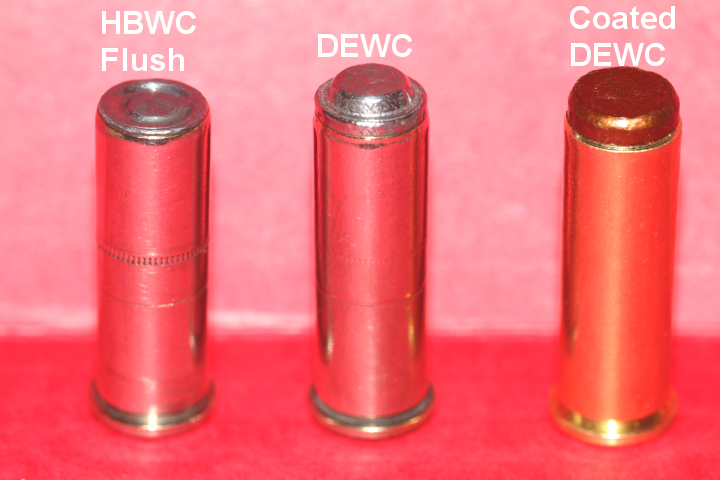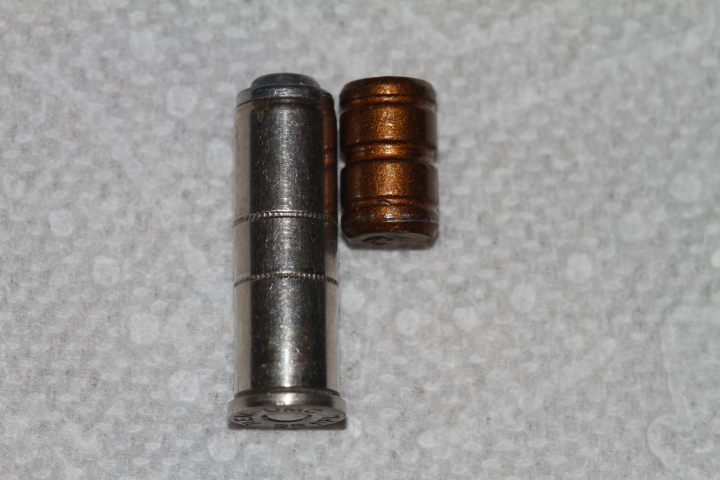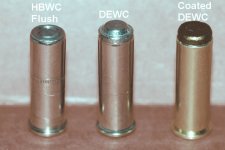SAMMI doesn't spec case inside dimensions, as the military does, so the manufacturers have lots of leeway to fiddle with things. The bottom line I see here is yet another excuse for bringing home a set of pin gauges. You find the one that just makes it into the fired case's brass, and see if it will slide in by the length of your WC before it stops where the brass is thickening or not.
You are using an out of date browser. It may not display this or other websites correctly.
You should upgrade or use an alternative browser.
You should upgrade or use an alternative browser.
Search: .38 Wadcutter Brass
- Thread starter LBussy
- Start date
I load a lot of wadcutters (DEWC's, specifically).
Sure seems like we're pretty deep in the weeds here. I have to wonder how critical this all is.
I do load like brass and try to keep things consistent and uniform. And going just that far seems to have my bullets going nice n straight for me.
Sure seems like we're pretty deep in the weeds here. I have to wonder how critical this all is.
I do load like brass and try to keep things consistent and uniform. And going just that far seems to have my bullets going nice n straight for me.
Sure seems like we're pretty deep in the weeds here. I have to wonder how critical this all is.
Pretty much my point, however I'll admit the thin section at the end of my calipers is only about 7/16" so it's possible that the brass I sampled started getting thicker just beyond that. I'm just having a hard time believing a big brass maker has a separately engineered and manufactured line of brass just for wad cutter ammo. I absolutely could be wrong though, maybe it's easy (and profitable) for them to make changes in internal dimensions.
Carriertxv
New member
I've got a lot of Federal American Eagle 38 brass that had 130 grain fmj bullet in them that I bought several new cases of and they all have that cannelure. So whats up with that??
condor bravo
New member
In addition to the Federal .38 wadcutter Match ammunition, I also have boxes of Winchester .38 Super Match wadcutter ammunition that have dual cannelures on the cases. The top cannelure is exactly the same distance below the neck as the single cannelure on the Federal match cases. So it would appear that the cannelure locations are there for a purpose, to accommodate wadcutter bullets seated to the cannelure depths and rightly can be called wadcutter cases.
In the 19th Century, when they still parked bullets in cases with hand tools sometimes, the case cannelure was an even deeper crease serving as a bullet stop so the lady pushing the bullets into them on the line didn't push them too far. With modern brass, it is mainly used just as a load identifier, AFAIK. For example, Lake City put cannelure's on their M852 brass down by the head. It was made with 168 grain Sierra HP match bullets, and the Adjutant General ruling allowing non-expanding hollowpoints, as these match bullets have, had not yet been made, so they wanted a quick check to ensure these rounds were not shipped for use in combat, and the cannelure was it. Additionally, the box said it wasn't for combat, but this was redundant insurance, I suppose.
the case cannelure was an even deeper crease serving as a bullet stop so the lady pushing the bullets into them on the line didn't push them too far.
AGAIN: If the case has a cannelure/knurled ring around the case I use the ring to sort cases. I have a cannelure machine that is used to roll a cannelure onto bullets, if I decide to place a cannelure on a case I have to support the case from the inside. If the support fits the case getting the support out of the case can be a problem.
And I wonder; was the ring around the case used as a bullet stop or did the ring abound the case prevent the bullet from seating deeper due to recoil. And then there is rolling the ring around the case after the bullet is seated, before that there was 'the stake'.
F. Guffey
And I wonder; was the ring around the case used as a bullet stop or did the ring abound the case prevent the bullet from seating deeper due to recoil. And then there is rolling the ring around the case after the bullet is seated, before that there was 'the stake'.
Obviously the case cannelure was not done to prevent the bullet from seating deeper due to recoil, since recoil in a revolver would only possibly cause the bullet to somewhat extract itself and lengthen COAL.
Don
Obviously the case cannelure was not done to prevent the bullet from seating deeper due to recoil,
True but if I rolled the case with a dent/cannelure around the case half way between the base of the bullet and bullet crimp the bullet would be limited in travel, and then there is that occasional 'bump', I do not want the bullet to move because I bumped it on something.
And if I had a roller with a knurled pattern; who knows?
F. Guffey
The cases looked familiar. The case on the left in the upper image and I forgot who made it but it is around here somewhere and the lower image is a REM-UMC nickel plated case with a wad cutter bullet beside it. Yes, my alignment sucks. The lower image is a factory load going back maybe 30 years or so. I have not seen any new or recent production 38 Special WC factory stuff in years.


Sorry about the color in the upper image, just do not look at it too long.
Ron


Sorry about the color in the upper image, just do not look at it too long.
Ron
condor bravo
New member
But is the middle round a duel end? It looks like a button type end and certainly would not fit in a Smith 52 magazine that requires a flush wadcutter, ala duel end type. Neither would the coated DEWC as shown unless seated flush.
But is the middle round a duel end? It looks like a button type end and certainly would not fit in a Smith 52 magazine that requires a flush wadcutter, ala duel end type.
I really don't know. Years ago I had a S&W 52 which I loaded for as well as bought ammunition for. I regret selling that gun and every now and then I find half boxes of ammunition for it and ammunition I loaded and put in labeled plastic cases. The photo was recent as the round on the right I loaded in Starline 38 Special brass and the bullets were from Missouri Bullet. I loaded them for a S&W revolver. Maybe over the winter I'll get to the indoor range and shoot some of this stuff.
Ron
148 gn Remington HBWC at Midway now (yes I have a box coming).
Remington Match Bullets 38 Caliber (360 Diameter) 148 Grain Lead Hollow Base Wadcutter
https://www.midwayusa.com/product/3...diameter-148-grain-lead-hollow-base-wadcutter
Remington Match Bullets 38 Caliber (360 Diameter) 148 Grain Lead Hollow Base Wadcutter
https://www.midwayusa.com/product/3...diameter-148-grain-lead-hollow-base-wadcutter
Last edited:

